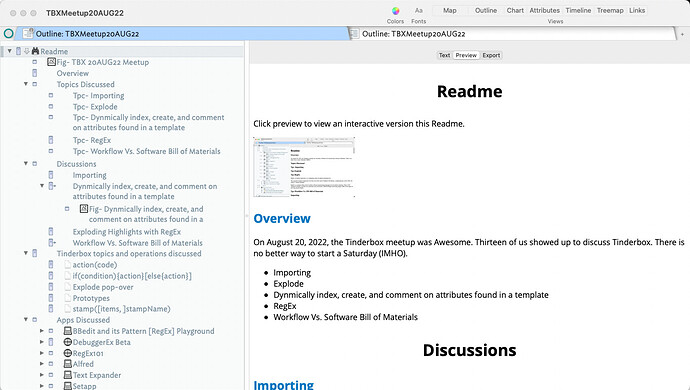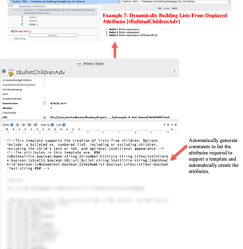Tinderbox Meetup - Sat. Aug. 20, 2022: Importing, Explode, and RegEx
| Level | All Levels |
| Published Date | 8/20/22 |
| Revisoin | 3 |
| Revisoin Note | R3 21AUG22: Modifed templates, added links to aTbRef; R2 20AUG22: dded details on stamp( ) action and top Becker dynamic attribute detection, creation, and template commenting demo, added images to the zip file |
| Type | Meetup |
| Tags | 5CsKM, Explode, Highlights, Import, Kindle, RegEx, Rendering Notes, Software Bill of Materials, Tinderbox, Workflow |
| Video Length | 01:39:00 |
| Video URL | Tinderbox Meetup - Sat. Aug. 20, 2022: Importing, Explode, and RegEx - YouTube |
| Example File | TBXMeeup20AUG22R3.zip (4.2 MB), includes a sample TBX file and images |
| TBX Version | 9.3 |
| Instructor | Michael Becker |
Overview
On August 20, 2022, the Tinderbox meetup was Awesome. Thirteen of us showed up to discuss Tinderbox. There is no better way to start a Saturday (IMHO).
Topics Discussed
- Importing
- Dynamically Index, Create, And Comment On Attributes Found In A Template
- Explode
- RegEx
- Workflow Vs. SW Bill of Materials
Discussions
Importing
David was interested in importing. We discussed importing with CSV and TSV reliable. We then moved on to demonstrate how to Explode, with RegEx, can be used to “render” your imported notes. This discussion happened before we started the recording.
Dynmically index, create and comment on attributes found in a template
Becker demonstrated a handful of functions he developed that dynamically detect the attributes in a template, create the attributes if they don’t already exist in the file, and add comments to the template code. He developed this to help him move his templates between Tinderbox files.
He will be refining this process and template with his Patrons.
Exploding Highlights with RegEx
The majority of the meetup was on this topic. Using an example—Amazon Kindle Highlighting—we reviewed several examples of how to import Kindle highlights into Tinderbox and then how to use Explode, prototypes, action code, and RegEx to render, a.k.a. atomize, the highlights into native digital text. This included creating a series of stamps to clean up the text, using RegEx back-references to pull text out of the $Text and populating attributes (e.g. page number).
Workflow Vs. Software Bill of Materials
See the forum thread to review @dominiquerenauld writing workflow and Becker’s input.
Also see [An end-to-end Professional, Academic, & Personal 5Cs of Knowledge Management Workflow] (An end-to-end Professional, Academic, & Personal 5Cs of Knowledge Management Workflow (Updated))
Tinderbox Topics And Operations Discussed
We use the following Tinderbox concepts, dialogs, and operators in this demonstration.
action(code)
This method is often referred to as a code note.
We demonstrated the concept of a code note, i.e., using the name of a note in a Stamp to call the action code—a few things on this point. The video or demo failed. It failed because of two reasons. First, for code notes to work, you must add the Built-in-Hints from the File menu. Secondly, we found a bug—the action is not recognized if it is the first line of the stamp (we’ve reported this to Eastgate). I’ve made the necessary adjustments in the sample file that includes this code.
Note, it turns out that this is not the best method to call a stamp see stamp([items, ]stampName).
To read up on action(code) click visit aTbRef.
if(condition){action}[else{action}]
In this use case, we used an if condition with RegEx to create a back-reference to populate the value of an attribute.
To read up on if(condition){action}[else{action}] click visit aTbRef.
Explode pop-over
We used various methods and strategies with Explode to parse the notes (a.k.a. highlights).
To read up on Explode pop-over click visit aTbRef.
Prototypes
We created a pNote prototype to make it easier to work with the notes.
To read up on Prototypes click visit aTbRef.
stamp([items, ]stampName)
Following the meetup, Mark Anderson shared the stamp( ) action with me. Rather than using the action($Text( )) method to call a code note, you can use the stamp( ) method to call a stamp. I’ve added a sample stamp in this file.
To read up on stamp([items, ]stampName) click visit aTbRef.
Apps Discussed
BBedit and its Pattern [RegEx] Playground
Click here to read up on BBedit and its Pattern [RegEx] Playground .
DebuggerEx Beta
A RegEx engine with a graphical user interface.
Click here to read up on DebuggerEx Beta .
RegEx101
Click here to read up on RegEx101 .
Alfred
Click here to read up on Alfred .
Text Expander
Click here to read up on Text Expander .
Setapp
Click here to read up on Setapp .
Typinator
Click here to read up on Typinator .
TextSniper
Click here to read up on TextSniper .
From the Chat
Story: The Machine Stops
From Wikipedia:
“The Machine Stops” is a science fiction short story (12,300 words) by E. M. Forster. After initial publication in The Oxford and Cambridge Review (November 1909), the story was republished in Forster’s The Eternal Moment and Other Stories in 1928. After being voted one of the best novellas up to 1965, it was included that same year in the populist anthology Modern Short Stories.[1] In 1973 it was also included in The Science Fiction Hall of Fame, Volume Two.
The story, set in a world where humanity lives underground and relies on a giant machine to provide its needs, predicted technologies similar to instant messaging and the Internet.”
History: Backstory to RegEx
RegEx, or regular expression, is a computing syntax for pattern-matching text.
The concept of regular expressions was born out of the work of Stephen Cole Kleene, a mathematician, in the 1905s. He called it “regular language.”
RegEx is a common utility used in modern software programming languages for text pattern matching. There is NO standard for RegEx, but there are commonly used concessions. Different RegEx processing engines differ at the edges on how they process RegEx.
Reference Material
Complete video list
You’ll find a Tinderbox reference file for this video on the Tinderbox Forum: Mastering Tinderbox: Training Videos (Complete List)
Need more help with Tinderbox?
If you need more help with Tinderbox, come on over to the Tinderbox Forum, https://forum.eastgate.com/, a vibrant community with members the revel in helping each other. You’ll find every walk of life at the forum—academics, authors, musicians, engineers, scientists, artists, philosophers, lawyers, doctors, and more, who are all looking to use Tinderbox, and related apps (like DevonThink, TexExpander, Zotero, Pandoc, BBEdit, Highlights, etc.) to manage the 5Cs of knowledge-making and exchange (collection, curation, creation, and contribution). Ask your question and you will be answered. We also hold weekly meetups to discuss Tinderbox how-tos, strategies, tactics, share examples, and more.
About Instructor: Michael Becker
I am strategic advisor, author, speaker, and educator. I am founder and CEO of Identity Praxis, a personal data & identity (PD&I) strategic consultancy. I offers product development, market development, business development, and marketing services to Fortune 500s, startups, and non-profits worldwide. I help them envision the future and work with them to achieve their goals. As an educator, I am developing the 5Cs of the Knowledge Management System (Tinderbox sits at the core of this system), a also teach CalPol Pomona and National University and offer Tinderbox consulting and courses.
I welcome the opportunity to connect and collaborate.
LinkedIn: https://www.linkedin.com/in/privacyshaman
You’re Invite to Become My Patron
My goal in life is to inform, inspire, educate, and help people execute to achieve their aspirations and goals. I am a strategic product, market, and business development advisor, a speaker, a writer, an educator, and a student. I’m extremely passionate about identity and personal information management and developing solutions that will help people take control and ownership of their identity and personal data. I’m also enthralled with Tinderbox, an amazing tool that will empower you and help sent your insights free. Tinderbox can be your second brain. It will help you master the 4Cs of knowledge management: collection, curation, creation, and contribution.
I would be grateful for your support. These training materials take a significant amount of time and resources. I am a teacher for all, whether you have the means to provide support or not; however, if you do have the means, and are getting value from my materials, I would be grateful for your patronage.

